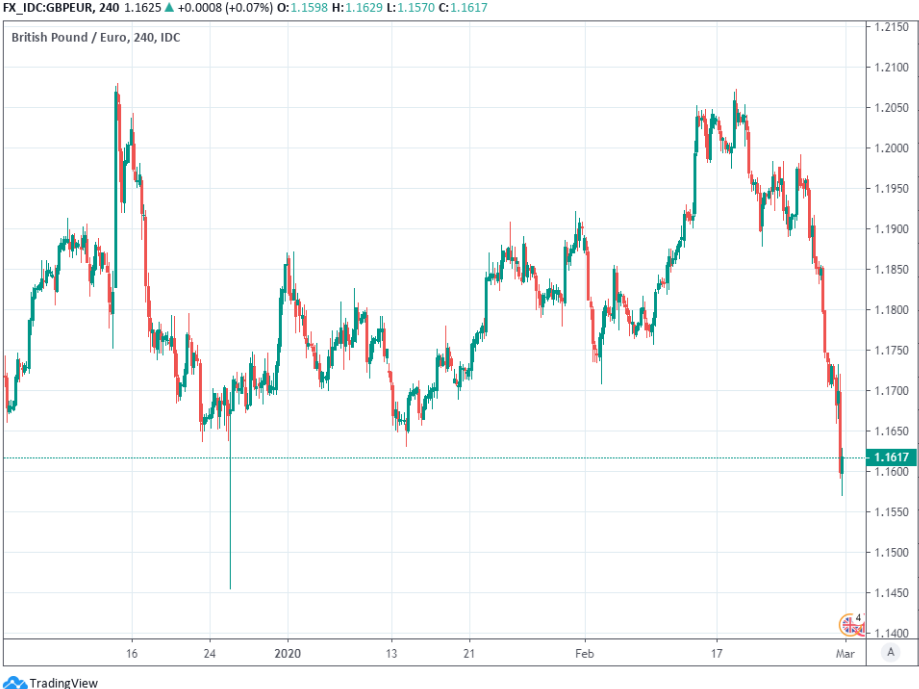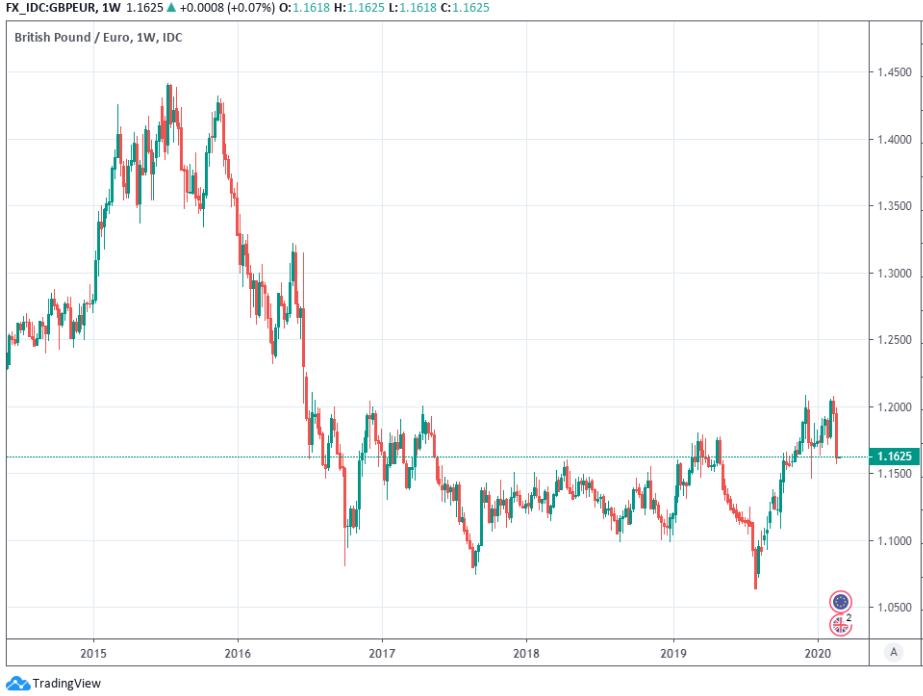The Pound-to-Euro Week Ahead: All Bets Are Off as Virus Outbreak Looms
- Written by: James Skinner
- GBP/EUR sees largest weekly loss since Oct 2016 flash crash.
- May mean respite due to GBP/EUR but all bets are off this week.
- Signs of 'community outbreak' of coronavirus near capital London.
- Surrey, Berkeshire both have cases of unexplained transmission.
- As virus outbreak grows in U.S., Italy, and other parts of Europe.
- Size of UK financial sector, threat to London, sees GBP vulnerable.
- EUR benefits from liquidation of 'carry' trades in emerging markets.

© IRStone, Adobe Stock
- GBP/EUR Spot rate: 1.1624, down -2.7% last week
- Indicative bank rates for transfers: 1.1317-1.1399
- Transfer specialist indicative rates: 1.1450-1.1519 >> Get your quote now
The Pound-to-Euro rate has suffered its largest decline since the flash crash of October 2016 but further losses cannot be ruled out for the coming days given a resilient performance from the Euro and an evolving coronavirus not-pandemic that could weigh disproportionately on Sterling.
Sterling has suffered heavy losses amid turmoil for risk assets like stocks and commodities as well as the currencies that underwrite them. In ordinary times such brutal punishment might be enough to mean that at least a short period of stabilisation was owed if-not due but this week, respite could be unlikely.
Some central bankers are of the view that recent price action in some markets represents an overreaction to the coronavirus on the part of investors but they know better than anybody that prices will reflect an average of possible outcomes for any given situation at any given time.
The uncomfortable reality for policymakers is that in the rapidly evolving coronavirus situation the worst case scenario outcome is potentially significant enough to mean the appropriate average for prices is skewed a long way below where valuations were, and possible even where they currently are sitting.
“EUR/GBP has rallied sharply through the downtrend at .8432 and increasingly looks to be a major base in development. A close above .8610 will confirm a move 200 day ma at .8746 and beyond,” says Karen Jones, head of technical analysis for currencies, commodities and bonds at Commerzbank.
Above: Pound-to-Euro rate shown at 4-hour intervals.
Jones says the Pound-to-Euro rate appears to have topped out after months in an uptrend and has warned that a daily close beneath the nearby 1.1614 level would condemn the exchange rate to a more protracted decline back to 1.1433.
This was before a first case of coronavirus was identified in England in which the disease was thought to have been “passed on in the UK,” Chief Medical Officer Chris Whitty said. Possibly the first sign of a 'community outbreak.’
A man and subsequently others were found with the viral pneumonia in an undisclosed part of the county of Surrey, which sits on the border of London. A primary school teacher in Reading, Berkeshire - another county bordering London - was confirmed to be suffering from virus. And there has since been an incidence of possible ‘community infection’ in Essex, another county bordering the capital London. The UK had 35 confirmed cases as of Sunday afternoon.
“The clear and obvious risk, which the financial markets are already contemplating, is that things get worse before they get better. That could include a further weakening in the global economy as the number of cases of coronavirus in Europe and the US rise and/or their governments shut down parts of their economies to control the spread of the virus,” says Paul Dales, chief UK economist at Capital Economics in a note to clients Friday.
Above: Pound-to-Euro rate shown at daily intervals.
The U.S. government also confirmed its first death case at the weekend and the White House has told Americans to expect more over the coming weeks. The Italian government had declared 1128 cases of coronavirus as of Saturday, with close to a thousand in the Lombardy, Veneto and Emilia-Romagna regions.
Eleven towns are under “lockdown” with nobody able to enter or leave affected areas and that government has now legislated to suspend payment deadlines for all debts to local authorities in the affected areas and provided for a EUR500 stipend to workers in those areas for at least the next three months.
The idea that such disruptive restrictions may soon be seen in the world’s most developed economies, and hubs of global finance, is no longer far-fetched.
"Coronavirus may very well be a challenge in the weeks and months ahead. But I have no doubt that with the help of the NHS and its incomparable staff this country will get through it – and beat it," says Prime Minister Boris Johnson, will chair a meeting of COBRA on Monday as the government prepares to publish an updated action plan on the response expected of the health care system and the public to COVID-19. Further details are below.
Above: Pound-to-Euro rate shown at weekly intervals.
AA
Pound Sterling: What to Watch
Pound Sterling received a drubbing heading into the weekend after the government put the idea of an ‘Australia deal’ Brexit on the table ahead of trade talks with the EU this week and as stock markets crumbled across the globe in response to the increasingly rapid spread of coronavirus outside of China, both being things that may continue to pressure the Pound in the week ahead.
The British government is expected to encourage companies to allow more staff to work from home in its updated action plan this week. It's also likely to discourage unnecessary travel as part of a ‘social distancing’ strategy that would delay the peak of the outbreak until later in the year.
It's also expected to allow the "emergency registration" of staff who've left the health service to combat staff shortages in the event of a large outbreak. The document will be published this week and will also outline steps the government will take to manage COVID-19 if there is a sustained UK epidemic.
This and the weekend’s events mean households, companies and investors could now potentially be facing a momentous disruption to the ordinary course of business and it's not possible for anybody to reliably say how long such disruption might last for or what other effects it could have. For Pound Sterling, which underwrites a financial sector where assets under management are more than three times the UK’s annual GDP, this could be very bad news.
"The pound is a structurally weak currency and it remains sensitive to global investors' appetite for risk. Large capital inflows are required to keep sterling stable, given that the U.K. runs a persistent current account deficit, equal to nearly 4% of GDP. Sterling depreciated by 25% during the 2007/08 crisis primarily due to a global pullback in cross-border finance, not a material shift in interest rate differentials," says Samuel Tombs, chief UK economist at Pantheon Macroeconomics. "If virus-related anxiety causes investors globally to pause on all risky acquisitions, or, in the worst case, de-risk their existing portfolios, sterling likely will struggle again."
Sterling is underpinned by continuous flows of external finance into and out of both the exchequer as well as City of London, although if a coronavirus outbreak were to be found on the borders of the capital then the City’s ability to continue functioning may be questioned. There are many different scenarios in which those financial inflows might dry up or be dwarfed by outflows from capital, and all of those scenarios would be bad news for the Pound.
Already the turmoil in financial markets was significant enough to have prompted some economists to contemplate the prospects of the Bank of England (BoE) feeling compelled to issue a statement over the coming days, and to potentially even cut interest rates in the weeks ahead. Pound Sterling is not prepared for an interest rate cut because on Friday the overnight-index-swap implied Bank Rate for March 26 was just 0.61%, above the 0.50% that would prevail following an actual cut.
Federal Reserve Chairman Jerome Powell already issued a statement on Friday evening.
“Even if the financial markets just continue to fear such developments and equity prices continue to fall by 3% a day, then the MPC may act. If so, then its next scheduled meeting on 26th March feels a long way away. It could release a statement before then, perhaps coordinated with other central banks, saying it is ready to provide support and liquidity if needed. And if that doesn’t do the job, we wouldn’t rule out the MPC cutting rates at an emergency meeting,” says Capital Economics’ Dales.
There are no major economic figures expected from the UK in the week ahead although the Brexit negotiations will begin in the shadow of the coronavirus story and with each side having conflicting demands and a confrontational stance.
This matters more for the Pound in the medium-term after the government said last week the UK could walk away from the trade talks with the EU if the broad outline of a deal has not been reached before June.
“The UK and the EU will sit at the negotiating table on Monday and we suspect the highly confrontational tone after the recent remarks by UK officials will keep prevailing in the headlines. This should translate into additional uncertainty regarding the future of UK trade relationships with the bloc and selling pressure on sterling should remain sustained,” says Chris Turner, head of FX strategy at ING. “In light of this we may see EUR/GBP consolidate above 0.85 and GBP/USD edging below 1.28 next week.”
AA
The Euro: What to Watch
The Euro outperformed all major currencies other than the safe-haven Japanese Yen last week as global stock markets fell apart and investors walked away from emerging market currencies in the their droves, and it has scope to continue outperforming in the short-term although analysts say not to be fooled and that the single currency will come back down to earth before long.
Europe’s single currency saw its biggest gains over the Dollar last week since August 2019 when China sent its Yuan falling to a decade-low, prompting steep losses for other emerging market currencies in the process. This was as coronavirus crept its way further beyond the borders of China, pushing deeper into Italy and France while also making a first appearance in many other European Union countries, not to mention the U.S. and other parts of the world.
Emerging market currencies have been sold and stock markets have slumped into ‘correction’ territory across Europe and North America and are now just steps away from the 20% losses that would signal a ‘bear market.’
“It is more of a position wash out,” says Jordan Rochester, a strategist at Nomura, of price action in the EUR/USD rate. “Short-term squeezes in EUR higher are possible due to leveraged fund positions closing out of carry trades, but real money positions are still net long and any reduction could also provide a headwind for EUR once the dust settles.
Europe’s single currency benefits from the recent pandemonium because negative European Central Bank (ECB) interest rates have made the Euro a popular 'funding currency' that sees investors borrow and then sell it in order to 'fund' bets on higher-yielding assets further afield. 'Carry trades" can result in the Euro-to-Dollar rate falling as stocks, commodities and emerging market currencies rise, only for the tables to turn as the apple cart rolls over.
It’s not clear what the path ahead has in store for emerging markets but Rochester says “rebalancing flows” could upset stock markets and keep the Euro supported into month-end, although he’s a seller of the Euro and is looking for it to decline to between 1.06 and 1.07 over the coming months.
“Despite some better activity data in January, the fear is that Covid-19 will hit Europe hard in 1H20 and that is why we view the current EUR/USD rally as short-term and corrective in nature,” says ING’s Turner. “The ECB will be in no mood to jump in with a pre-emptive rate cuts, but could be forced to act were equities to continue to fall hard. Here the market looks like it is pricing a 10bp ECB rate cut over coming months. It is still not clear the ECB would go with a rate cut – e.g. an increase in the tiering of deposits is another option – but we hear little from the ECB ahead of the 12 March meeting.”
Price action will doubtless be dominated by the coronavirus story but the Eurozone will also see its first estimates of retail sales and inflation, although it’s not clear what impact they’ll have on exchange rates.
Markets are looking for inflation to have held at 1.4% in February, with core inflation at 1.1% when the numbers are released at 10:00 Tuesday while consensus is for Eurozone retail sales to have risen 0.6% in January when the number is released at 10:00 Wednesday.
“The perceived likelihood of a #covid19recession in Italy and perhaps for the Euro area as a whole has surely been sky-rocketing over the past week. The Euro-area manufacturing sector has been weak for a long while, and limiting movement of goods and people can’t be anything but bad news...For countries such as Italy, the service sector will also be hit hard as tourism will be severely affected,” says Martin Enlund, chief FX strategist at Nordea Markets. “EUR/USD looks nicely and inversely correlated with the S&P500 future for now.”







